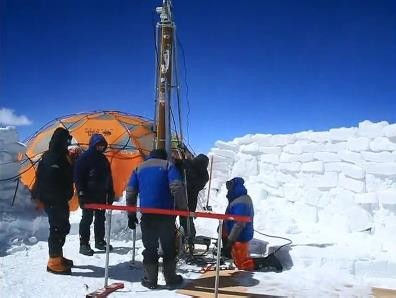A team of scientists from five countries recently went to the Qinghai-Tibetan Plateau to drill 6 metric tons of ice cores, believed to be the oldest ice on Earth's so-called Third Pole, as part of a project to study climate change, the China Daily reported.
"These ice cores are one of the most precious things in the world. Since glaciers are retreating fast, in the near future the ice will disappear together with the information it holds," Yao Tandong, director of the Chinese Academy of Sciences' Institute of Tibetan Plateau Research, said.
According to the report, Yao led the team of scientists from China, the U.S., Russia, Italy and Peru to the Guliya ice cap near the junction of Tibet and Xinjiang Uyghur Autonomous Regions in late August. The team spent more than two months at the area with altitudes between 6,000 and 7,000 meters and collected six ice samples from 308 meters deep.
The report said that the ice cores were shipped late October from Lhasa, Tibet, to a refrigeration house in Beijing. Some of the cores will be transported later to the United States for further study.
According to an email sent to China Daily by Lonnie G. Thompson, a paleo-climatologist from Ohio State University in the U.S., scientists from several countries will assess the climate signals embedded in the ice over the last 100,000 years by measuring high-resolution images of dust, trace elements and black carbon at selected intervals of the cores.
"On the longer time periods, we hope to document abrupt climate variations, both past and present, and establish tightly constrained time scales on the ice cores through the use of new dating techniques that did not exist in 1992," Thompson said. "We also hope to assess the regional characteristics of climatic and environmental variability over decades to millennial time periods, and to determine how they compare with conditions elsewhere, including the Polar Regions."
Scientists had visited the Guliya cap once in 1992 and drilled some ice cores at the same site. The samples are currently preserved at a refrigeration house in Lanzhou, Gansu Province.
In 1997, the journal Science published an analysis of those ice cores that was widely discussed by the scientific community.
"Last time we focused more on mining climate information over hundreds of thousands of years from the ice core. This time we will also emphasize the change of temperature, precipitation, dust and plants over the past century," Wu Guangjian, a researcher at the institute, said.
Yao, the institute's director, said that by comparing the new cores with the old ones, they can find out if climate change in other regions of China had affected glaciers over the past two decades, or understand the reasons for retreating glaciers.
"The comparison on climate change over a short period is more meaningful on the Qinghai-Tibetan Plateau compared with Antarctica, because the high accumulation on the plateau makes it easier to identify the time scale of climate change," Yao said.
The Qinghai-Tibetan Plateau has been gaining importance for providing early indications of climate and environmental changes. The area, now known as the Third Pole region, has become a hot spot for climate research due to the deepest levels of ice outside of the north and south poles.
In 2009, the Chinese Academy of Sciences began the Third Pole Environment Program to focus international research on key environmental aspects of the plateau and nearby regions.
Recently, 6 tons of ice core samples from the plateau were taken by the group of scientists from five countries.
Thompson said that recovering the climate records of the Third Pole Region is as valuable as a "global salvage mission."
"These ice archives of our past are disappearing quickly across the Third Pole Region due to mass loss, often from the surface down. It is important to recover these records before they are lost forever," Thompson said.
Vladimir Mikhalenko, a research professor from the Institute of Geography, Russian Academy of Sciences, said that the ice cap is an important key to solving the enigmas of Tibet's climate.
"The combination of low ice temperature, surface snow accumulation rate, and 300 meter ice thickness allow (for the expectation of) finding the most ancient ice at the Tibetan Plateau," Mikhalenko explained. "If our expectations are confirmed by ice core analyses, we can reconstruct climate and environmental conditions in Tibet for many thousands of years. This result will be comparable with Antarctic and Greenland ice core records."



























